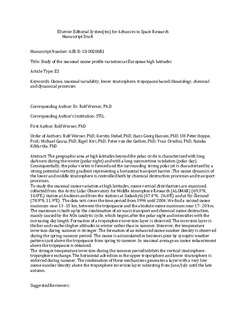| dc.contributor.author | Werner, R. | |
| dc.contributor.author | Stebel, Kerstin | |
| dc.contributor.author | Hansen, Georg Heinrich | |
| dc.contributor.author | Hoppe, Ulf-Peter | |
| dc.contributor.author | Gausa, Michael | |
| dc.contributor.author | Kivi, R. | |
| dc.contributor.author | Gathen, P. von der | |
| dc.contributor.author | Orsolini, Yvan | |
| dc.contributor.author | Kilifarska, N. | |
| dc.date.accessioned | 2017-12-04T12:16:13Z | |
| dc.date.available | 2017-12-04T12:16:13Z | |
| dc.date.created | 2011-01-06T14:01:55Z | |
| dc.date.issued | 2011 | |
| dc.identifier.citation | Werner, R., Stebel, K., Hansen, G.H., Hoppe, U.-P., Gausa, M., Kivi, R., von der Gathen, P., Orsolini, Y., Kilifarska, N. (2011). Study of the seasonal ozone variations at European high latitudes. Adv. Space Res., 47, 740-747. doi:10.1016/j.asr.2010.09.029 | nb_NO |
| dc.identifier.issn | 0273-1177 | |
| dc.identifier.uri | http://hdl.handle.net/11250/2469016 | |
| dc.description.abstract | The geographic area at high latitudes beyond the polar circle is characterized with long darkness during the winter (polar night) and with a long summertime insolation (polar day). Consequentially, the polar vortex is formed and the surrounding strong polar jet is characterized by a strong potential vorticity gradient representing a horizontal transport barrier. The ozone dynamics of the lower and middle stratosphere is controlled both by chemical destruction processes and transport processes. To study the seasonal ozone variation at high latitudes, ozone vertical distributions are examined, collected from the Arctic Lidar Observatory for Middle Atmosphere Research (ALOMAR) (69.3°N, 16.0°E,) station at Andenes and from the stations at Sodankylä (67.4°N, 26.6°E) and at Ny-Ålesund (78.9°N, 11.9°E). The data sets cover the time period from 1994 until 2004. We find a second ozone maximum near 13–15 km, between the tropopause and the absolute ozone maximum near 17–20 km. The maximum is built up by the combination of air mass transport and chemical ozone destruction, mainly caused by the NOx catalytic cycle, which begins after the polar night and intensifies with the increasing day length. Formation of a troposphere inversion layer is observed. The inversion layer is thicker and reaches higher altitudes in winter rather than in summer. However, the temperature inversion during summer is stronger. The formation of an enhanced ozone number density is observed during the spring–summer period. The ozone is accumulated or becomes poor by synoptic weather patterns just above the tropopause from spring to summer. In seasonal average an ozone enhancement above the tropopause is obtained. The stronger temperature inversion during the summer period inhibits the vertical stratosphere–troposphere exchange. The horizontal advection in the upper troposphere and lower stratosphere is enforced during summer. The combination of these mechanisms generates a layer with a very low ozone number density above the troposphere inversion layer subsisting from June/July until the late autumn. | nb_NO |
| dc.language.iso | eng | nb_NO |
| dc.rights | Attribution-NonCommercial-NoDerivatives 4.0 Internasjonal | * |
| dc.rights.uri | http://creativecommons.org/licenses/by-nc-nd/4.0/deed.no | * |
| dc.title | Study of the seasonal ozone variations at European high latitudes | nb_NO |
| dc.type | Journal article | nb_NO |
| dc.type | Peer reviewed | nb_NO |
| dc.description.version | acceptedVersion | nb_NO |
| dc.rights.holder | © 2010 COSPAR. Published by Elsevier Ltd. All rights reserved | nb_NO |
| dc.source.pagenumber | 740-747 | nb_NO |
| dc.source.volume | 47 | nb_NO |
| dc.source.journal | Advances in Space Research | nb_NO |
| dc.source.issue | 4 | nb_NO |
| dc.identifier.doi | 10.1016/j.asr.2010.09.029 | |
| dc.identifier.cristin | 518653 | |
| cristin.unitcode | 7460,57,0,0 | |
| cristin.unitname | Atmosfære og klima | |
| cristin.ispublished | true | |
| cristin.fulltext | postprint | |
| cristin.qualitycode | 1 | |

